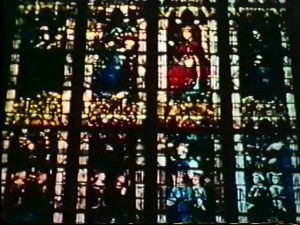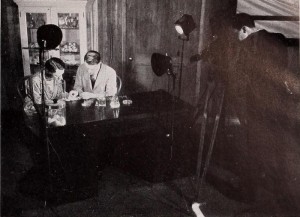"Two Minutes to Play, running two reels, 16mm., and a production of the Greenbrier Amateur Movie Club under the direction of Hal Morey, ACL, stands out among the year's films because of its unusually deft cutting and shrewd camera treatment. Although plotted on the standard football yarn, the picture tells its story swiftly, smoothly and with a rising tempo of excitement that is a direct tribute to the production and to the editing. Consistently good photography, effective and varied camera angles and a well planned script were contributing factors in the success of this genuinely entertaining film story." Movie Makers, Dec. 1932, 538.

"Studies in Blue and Chartres Cathedral, a cerulean cinema achievement, one 400 foot reel in full Kodacolor by John V. Hansen, ACL, shows what an artist's and a colorist's eye can select and record. While this film is in some sense a travel record, Mr. Hansen definitely made it a point to choose those scenes and vistas that revealed the open sky, whether seen in patches through the interlaced branches of trees or as a dim, distance haze, shimmering up from the tops of far off mountains. Here are deep blue skies overhead, merging into white mist at the horizon, apple green, azure, so many hues that it is a revelation to see that a mechanical process can so beautifully record nature. Mr. Hansen presents to the audience's eyes such a varying kaleidoscope of blending colors in his continuity that it is difficult to do the entire effect justice by mere description. But among his outstanding technical achievements are the recording of sunlit glades in a dense forest, especially effective cloud and sunset shots, distant and close shots and side lighting and backlighting in profusion. A further, outstanding triumph in color technique was shown in Mr. Hansen's recording of the vivid, glowing hues of the stained glass windows, taken from the interior of the cathedral at Chartres. Here, he succeeded in capturing that peculiar, deep dyed transparency found only in the colors of old stained glass. It is questionable if any other method of reproducing color can give such a real and beautiful rendition of stained windows as the motion picture. Certainly no color printing process can compete. The film was rounded out by some charming long shots of the carefully cultivated, rolling hills of Denmark." Movie Makers, Dec. 1932, 538, 560.
"Garden Closeups, by W. T. McCarthy, ACL, demonstrates its right to be placed among the ten best films because of the painstaking care and time expended in its preparation and because of the exceptional results achieved. The film covers a subject which is almost entirely in miniature, but which, in its motion picture interpretation, reveals a whole new world which only the eye of a discriminating filmer and a nature lover could catch. Here are excellent closeups of the common varieties of garden flower, pictured so skillfully that the technique used is forgotten and the actual, living flower seems revealed on the screen, sometimes swaying gently in the breeze, sometimes rifled by a gigantic bumblebee pictured in alarming closeup. Another sequence will show the honeycombed intricacies of a wasp's nest, a time condensation technique showing its gradual cessation of activity as the winter comes on. An outstanding achievement in closeup technique showed the praying mantis in the very unprayerful act of devouring its victim. The film was made almost entirely with the aid of a telephoto lens with special extension, which enabled the patient cameraman to capture his flower and insect subjects from a moderate distance. Focus and exposure alike show the result of painstaking care in Garden Closeups." Movie Makers, Dec. 1932, 560.
"The seven reel industrial film made by Sherman A. MacGregory, ACL, of the construction of a sewage treatment plant was placed among the year's ten best because of its exact and thorough handling of a difficult subject. For more than five months Mr. MacGregory served as construction engineer and cameraman on a job that progressed slowly through many stages. But only by recording in detail all of these stages could he make the film serve its purpose efficiently as an office record — with the result that 4000 feet of 16mm. film were exposed in the process. In the final, carefully edited and titled edition, Mr. MacGregory has achieved and sustained definite interest, even for the layman, in a film subject that threatened monotony at every turn. Unusual and effective camera positions played a large part in this as a complement to the exact production and editing." Movie Makers, Dec. 1932, 560.
"Canadian Capers, filmed by Hamilton H. Jones, ACL, is a superlatively good vacation picture, complete in every important detail and containing several magnificent examples of sequencing. Among these is a satisfying study of a railway train. Mr. Jones neglected none of the cinematically interesting views that are unique to this subject and included several, such as scenes inside the engine cab, that ordinarily could not be secured. This picture has the important quality of conveying to the audience the maker's enthusiasm for the subjects filmed." Movie Makers, Dec. 1932, 560.

"The six reel film, Technical Methods in Cancer Research, produced by Francis Carter Wood, jr., ACL, for the American Journal of Cancer, is the most distinguished and thoroughgoing scientific picture viewed this year in League headquarters. In it Mr. Wood, working in collaboration with his father, editor of the Journal, has presented in detail the many processes evolved and used at Crocker Institute of Columbia University in the treatment and study of cancer. Difficult details of clinical analysis are shown clearly with accurate lighting and unfailing definition. Laboratory bench work on specimen growths is supplemented by microscopic studies of corresponding cells. One entire reel is devoted to a unique stop motion study of leading cancer cells in living motion. Throughout the film Mr. Wood's camera treatment, editing and titling are polished and forceful." Movie Makers, Dec. 1932, 560.
"Thornwell Orphanage, planned and made by Willis Osborn, is a film study of Thornwell Orphanage, showing the scholastic, industrial and religious training of the youngsters there and presenting a subtle argument for its support. This is a difficult subject because of the problem of selecting significant and coherent action from among the almost endless possibilities. Most welfare films are too discursive and too general in treatment to secure the effect desired. Mr. Osborn has succeeded in avoiding this and has produced a film as coherent and informative as it is well photographed." Movie Makers, Dec. 1932, 560.
"Among the films awarded honorable mention is The Grand Teton Country, carrying with it a breadth and sweep of all outdoors, a Kodacolor film by H. W. Voss, ACL. This picture is, first of all, an eloquent and colorful reply to those who do not believe that long shots can be taken successfully by this process. Time and again, in viewing this film, one is astonished by the clarity and detail of distant mountains, rearing their majestic, snow capped heads up into the cold blue of the sky, while the foreground is shown in all of its true colors. Mr. Voss has proved to skeptical Easterners that Rainbow Falls really lives up to its name. His Kodacolor camera, skillfully handled so as to produce a dark background for the rainbow formed by the sun shining on the spray, reveals perfectly that faint, tenuous beauty which is all the more remembered because evanescent. But solid, palpable colors are pictured here, too. Mountains and canyons, lakes that are mirrors, desert flowers and all the glowing colors that are part of the West, are arranged on Mr. Voss's film palette. Especially well considered was his continued use of the various neutral density filters in order to give distant shots their correct value in the brilliant sun and the inclusion of interesting action in each scene." Movie Makers, Dec. 1932, 560-561.
"Drifting, a two reel photoplay produced under the direction of Jack Navin, ACL, is an old school melodrama, planned, played and directed to ring the last harsh change on the "wages of sin" motif. It is distinguished by consistently dramatic lighting, a smoothly sequenced filming plan and a definitely mature understanding of cinematic treatment. In it a large cast plays well and with a thorough seriousness that adds much charm to the original melodramatic conception." Movie Makers, Dec. 1932, 561.
"Another melodrama, delightful in its serious characterizations and adroit in its cutting and camera treatment, has been completed under the direction of Jack Navin, ACL, producer of Sophistication and Those Mad Barclays. The new work is Drifting, a direct descendant in the Navin tradition, as it tells a tale of the relentless downfall of too, too pretty Ellen Rowen in vain search of her kidnapped little brother. Once the toast of Paris, in the end a drab of Montreal slums, Ellen drifts inevitably to a harsh fate, protesting bitterly on her pathway that she "was once a lady." Elizabeth Sutherland played Ellen with " a defensive delicacy that was touching. Other parts were ably carried by Virginia Simmons, Margaret Newnan, Gretchen Rickel, Mary Reynolds, Nellie Navin, Martha Blodgett, Coman Munroe, Junie Newnan, Ted Newnan, Bobby Sutherland, Fred Griffiths, Bill Laurie, Thayer Hutchinson, Bob Drysdale, John Hutchinson, Edward Mackenzie, Bill Newnan, the Blodgetts and Mr. Navin."
Movie Makers, Dec. 1932, 575, 577.

"In Little Geezer, running 400 feet, Theodore Huff, ACL, has produced one of the most able and amusing burlesque film stories of the amateur year, repeating his success of that earlier satiric classic, Hearts of the West. Again he has used, with amazing directorial facility, the neighborhood youngsters as his only actors. Again he has aped, with his own peculiar genius, the threadbare cliches of professional drama, poking fun in his filming as well as his titling. Little Geezer offers fine examples of real cinema, is the sort of thing amateurs can do as well or better than professionals and is delightfully amusing in the process." Movie Makers, Dec. 1932, 561.
"Theodore Huff, ACL, has done it again! That lone wolf producer of Hearts Of The West has paralleled the gorgeous fun of his earlier panning of the purple plains as he takes the gangsters for a ride in Little Geezer. The Big Shot, his lieutenant, Greta Garbage (" — more to be pitied than sniffed at") and Scarface Macaroni are all there, played by the neighborhood kids, no one of them over eleven years old. Through their naively serious acting and his own genius at direction and editing. Mr. Huff has riddled with bursts of laughter the machine gun monarchy of professional filmdom." Movie Makers, Sept. 1932, 398.
Total Pages: 299